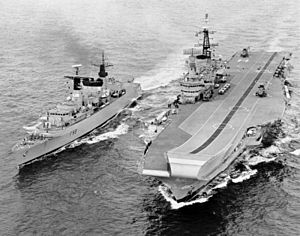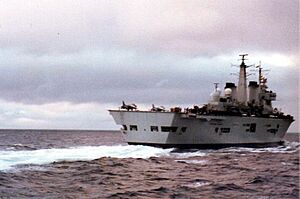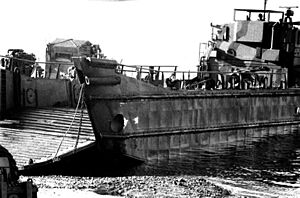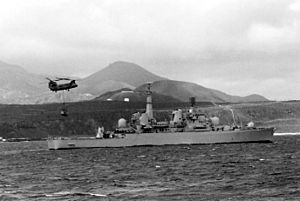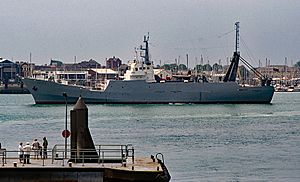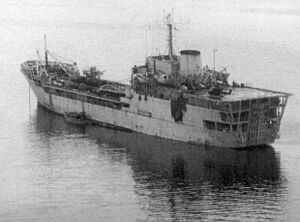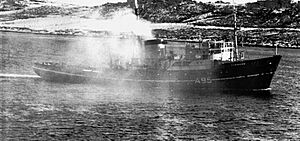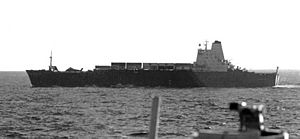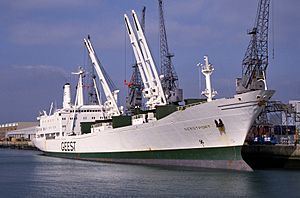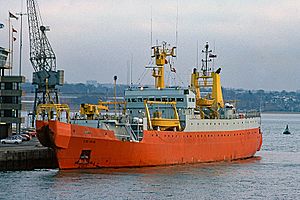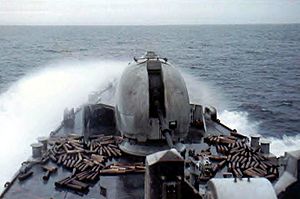British naval forces in the Falklands War facts for kids
The Falklands War in 1982 saw many ships from the United Kingdom travel a long way to the South Atlantic. These ships, along with their crews and aircraft, were often called "the Task Force". They played a huge part in the conflict. This list tells you about the different types of ships and their important roles during the war.
Contents
The Royal Navy is the UK's main naval force. During the Falklands War, their ships were led by important commanders both in London and closer to the action in the South Atlantic.
Commanders
- In London, Admiral Sir J.D.E. Fieldhouse was the Commander-in-Chief of the Fleet.
- In the South Atlantic, Rear-Admiral J.F. Woodward led the main Carrier/Battle Group from HMS Hermes.
- Commodore M.C. Clapp led the ships that carried troops and equipment for landing, from HMS Fearless.
Aircraft Carriers
Aircraft carriers are like floating airfields. They carry planes and helicopters that can take off and land on their decks.
- HMS Hermes: This was a very important ship, acting as the main command ship for the Carrier Group. It carried many BAE Sea Harrier fighter jets and Sea King helicopters. Sadly, three pilots were lost.
- HMS Invincible: This aircraft carrier also carried Sea Harriers and Sea King helicopters. Two Sea Harrier pilots were lost from this ship.
Landing Ships
These ships are designed to carry troops, vehicles, and equipment, and then land them on beaches.
- HMS Fearless: This ship was the main command ship for the landing forces. It carried smaller landing craft (LCU and LCVP) to get troops and vehicles ashore. One of its landing craft, Foxtrot Four, was bombed and sunk. Six people were sadly lost.
- HMS Intrepid: Like HMS Fearless, this ship also carried landing craft to help put troops and equipment onto the land.
Destroyers
Destroyers are fast warships with powerful weapons, good for defending other ships.
- HMS Bristol: A large destroyer that joined the fleet.
- HMS Sheffield: This ship was hit by an Exocet missile and caught fire. It sank a few days later, and 20 lives were sadly lost.
- HMS Coventry: This ship was sunk by bombs from enemy aircraft. Sadly, 19 lives were lost.
- HMS Glasgow: This ship was hit by a bomb that did not explode, but it was damaged enough to leave the war zone.
- HMS Cardiff: This destroyer joined the fleet later in the war.
- HMS Exeter: Another Type 42 destroyer that took part in the conflict.
- HMS Glamorgan: This ship was hit by an Exocet missile, causing major damage and the loss of 14 lives.
- HMS Antrim: This ship was hit by an unexploded bomb, but it was able to keep fighting.
Frigates
Frigates are smaller than destroyers but are also fast and well-armed, often used for protecting convoys and hunting submarines.
- HMS Brilliant: This frigate was hit by cannon fire but only had minor damage.
- HMS Broadsword: This ship was hit by cannon fire and later damaged by a bomb.
- HMS Active: A Type 21 frigate.
- HMS Alacrity: This ship sank an Argentine transport ship.
- HMS Antelope: This ship sank after unexploded bombs detonated during an attempt to make them safe. Sadly, two lives were lost.

- HMS Ardent: This ship was sunk by bombs from enemy aircraft. Sadly, 22 lives were lost.
- HMS Ambuscade: A Type 21 frigate.
- HMS Avenger: This frigate also took part in the fighting.
- HMS Arrow: This ship was hit by cannon fire, but only had minor damage.
- HMS Andromeda: A Leander-class frigate.
- HMS Argonaut: This ship was hit by cannon fire and unexploded bombs, causing major damage and the loss of two lives.
- HMS Minerva: Another Leander-class frigate.
- HMS Penelope: A Leander-class frigate.
- HMS Yarmouth: A Rothesay-class frigate.
- HMS Plymouth: This ship was hit by unexploded bombs, causing major damage.
- HMS Rhyl: This ship served as a guardship at Ascension Island.
- HMS Endurance: An ice patrol ship, used for patrolling icy waters.
- HMS Leeds Castle and HMS Dumbarton Castle: These patrol vessels helped carry mail and messages between the Task Force and Ascension Island.
Submarines
Submarines can travel underwater, making them very hard to detect. They are used for spying and attacking enemy ships.
- HMS Conqueror: This submarine famously sank the Argentine ship ARA General Belgrano.
- HMS Courageous: Another Churchill-class submarine.
- HMS Onyx: This submarine ran aground, causing moderate damage.
- HMS Valiant: This submarine had bombs dropped near it by enemy fighters, but only suffered minor damage.
- HMS Spartan: A Swiftsure-class submarine.
- HMS Splendid: Another Swiftsure-class submarine.
Survey and Minesweeping Ships
- HMS Hecla, HMS Herald, HMS Hydra: These were survey vessels, but during the war, they were used to carry injured people (like hospital ships).
- HMS Cordella, HMS Farnella, HMS Junella, HMS Northella, HMS Pict: These were civilian fishing trawlers that were quickly changed into minesweepers. They helped clear dangerous minefields near Port Stanley.
Royal Fleet Auxiliary (RFA)
The RFA ships are part of the Royal Navy's support fleet. They carry fuel, food, and supplies to the warships, allowing them to stay at sea for longer.
Tankers
These ships carry fuel for the warships.
- RFA Olna (A123)
- RFA Olmeda (A124)
- RFA Tidespring (A75)
- RFA Tidepool (A76)
- RFA Blue Rover (A270)
- RFA Appleleaf (A79)
- RFA Brambleleaf (A81)
- RFA Bayleaf (A109)
- RFA Plumleaf (A78)
- RFA Pearleaf (A77)
Landing Ship Logistics
These ships carry vehicles and supplies for landing operations. Their crews were British merchant seamen, joined by military personnel.
- RFA Sir Bedivere (L3004): This ship was bombed, but only had minor damage.
- RFA Sir Galahad (L3005): This ship was bombed twice and sadly sank, with 48 lives lost. It is now a war grave.
- RFA Sir Geraint (L3027)
- RFA Sir Lancelot (L3029): This ship was damaged by unexploded bombs.
- RFA Sir Percivale (L3036)
- RFA Sir Tristram (L3505): This ship was bombed, causing major damage and the loss of two lives.
Supply Ships
These ships carry food, ammunition, and other important supplies.
- RFA Regent (A486)
- RFA Resource (A480)
- RFA Fort Austin (A386)
- RFA Fort Grange (A385)
- RFA Stromness (A344): This ship was attacked but only had minor damage.
Helicopter Support Ship
- RFA Engadine (K08): This ship helped support helicopters.
Royal Maritime Auxiliary Service (RMAS)
These ships provide support services like towing and helping with moorings.
- RMAS Typhoon (A95)
- RMAS Goosander (A94)
Civilian Ships (STUFT)
Many civilian ships were quickly called into service by the military. This was known as "Ships Taken Up From Trade" (STUFT). They helped carry troops, vehicles, and supplies.
Liners
Large passenger ships used to carry many soldiers.
- SS Canberra: This large liner carried many troops, including the 3rd Commando Brigade.
- MV Queen Elizabeth 2: Another huge liner that carried over 3,000 soldiers.
- SS Uganda: This ship was used as a hospital ship, caring for injured personnel.
Roll-on-Roll-off (RORO) Ferries
These ferries allow vehicles to drive directly on and off, making them useful for carrying military equipment.
- Elk: Carried helicopters, ammunition, and heavy vehicles.
- Baltic Ferry: Carried helicopters, troops, and supplies.
- Europic Ferry: Carried vehicles, ammunition, and helicopters.
- Nordic Ferry: Carried troops, stores, and ammunition.
- Norland: Carried 800 paratroopers.
- Rangatira: Carried engineers and their equipment.
- St Edmund: Carried RAF crews, troops, and vehicles.
- Tor Caledonia: Carried vehicles and equipment.
Container / Cargo Ships
These ships carry large containers or general cargo.
- Atlantic Conveyor: This ship carried many helicopters and Harrier jets. It was hit by an Exocet missile and sank, sadly with 12 lives lost. Many important helicopters and equipment were also lost.
- Atlantic Causeway: Carried many Sea King and Wessex helicopters.
- Contender Bezant: Carried helicopters and Harriers. It was later bought by the Royal Navy.
- MV Myrmidon: Carried supplies and had temporary living spaces.
Freighters
Ships used for carrying various goods.
- Avelona Star: A refrigerated ship that carried food.
- Geestport: Another refrigerated ship that carried food and supplies.
- Laertes: Carried general supplies.
- Lycaon: Carried ammunition and supplies.
- Saxonia: A refrigerated ship that carried food.
- Strathewe: Carried supplies and landing craft.
- St Helena: Used to support minesweepers.
Tankers
Civilian tankers also helped carry fuel.
- Alvega: Used as a floating fuel storage at Ascension Island.
- Anco Charger: Carried many different liquids.
- Balder London
- British Avon
- British Dart
- British Esk
- British Tamar
- British Tay
- British Test
- British Trent
- British Wye: This ship was hit by a bomb, but only had minor damage.
- Eburna
- Fort Toronto: Carried fresh water.
- G.A.Walker
- Scottish Eagle: Used as a floating fuel storage at South Georgia.
Tugs / Repair / Support Ships
These ships provided various support services, like towing and repairing other vessels.
- British Enterprise III: A diving support ship.
- Iris: A cable ship used for carrying messages.
- Irishman: An ocean salvage tug.
- Salvageman: A very powerful ocean salvage tug.
- Stena Inspector: Used as a repair ship. It was later bought by the Royal Navy.
- Stena Seaspread: A diving and repair ship that fixed over 50 ships during the war, including many warships.
- Wimpey Seahorse: Used as a tug and for mooring.
- Yorkshireman: Another ocean salvage tug.
Weaponry
The ships used many different types of weapons to defend themselves and attack enemy targets.
- Missiles that hit aircraft:
- Sea Slug
- Sea Cat
- Sea Wolf
- Sea Dart
- Missiles that hit ships:
- Aérospatiale MM38 Exocet
- Ikara (used against submarines)
- Guns:
- Large 4.5 inch (114 mm) naval guns
- Bofors 40 mm anti-aircraft guns
- Oerlikon 20 mm anti-aircraft guns
- L7A2 7.62 mm GPMG machine guns
- Anti-submarine weapons:
- Limbo Mark 10 mortars
- Torpedoes:
- Mark 24 Tigerfish torpedo
- Mark 8 torpedo
See also
Images for kids


